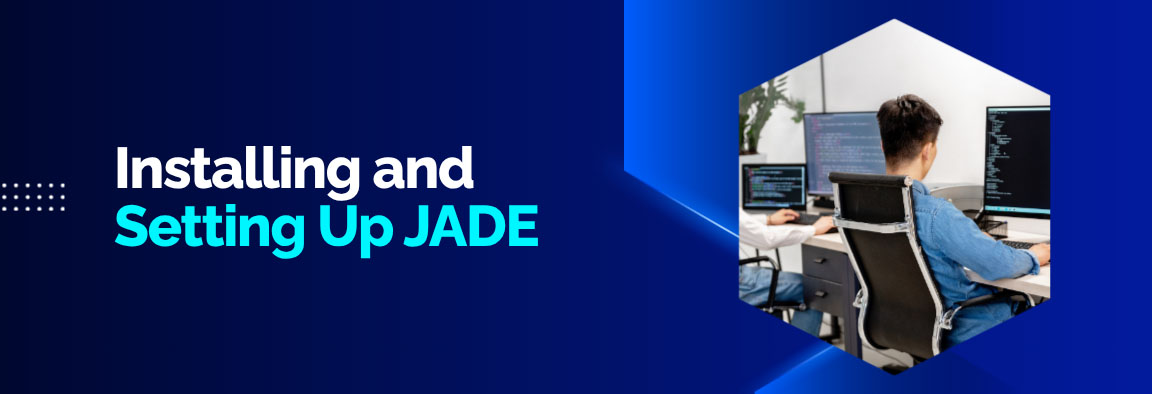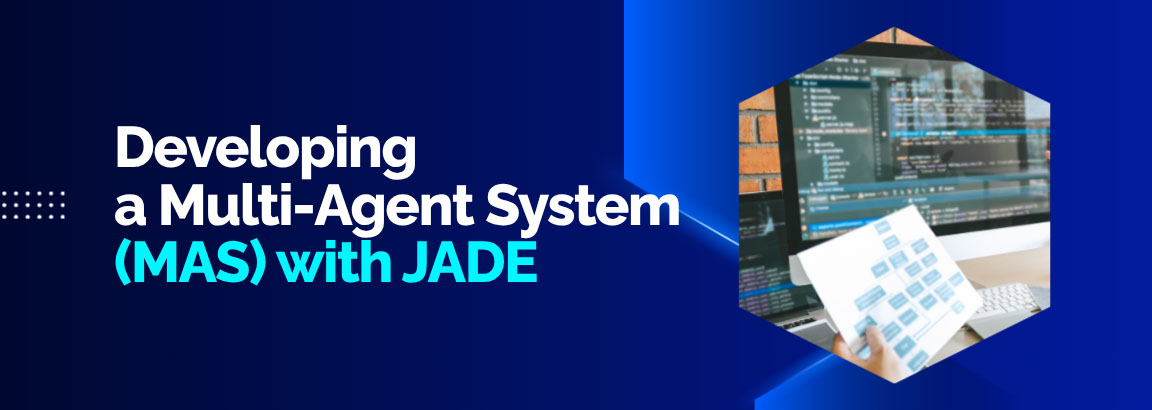Web Development, zBlog
JADE (Java Agent Development Framework) — A Practical Guide for Java Developers
trantorindia | Updated: October 31, 2025

In today’s fast-paced digital world, the ability to create intelligent, autonomous, and adaptable software agents has become a game-changer for enterprises and developers alike. If you’re a Java developer looking to explore this exciting realm, the JADE (Java Agent Development Framework) stands out as one of the most robust, flexible, and widely adopted platforms.
In this comprehensive guide, we aim to demystify JADE (Java Agent Development Framework), explaining its core concepts, practical applications, setup, development practices, and how it can revolutionize your projects — whether you’re building a multi-agent system, automation tools, or AI-driven applications.
As we walk through the ins and outs of JADE, we will also review real-world case studies, provide best practices, and demonstrate how to leverage the framework for an array of use cases—from simple tasks to complex enterprise solutions. By the end of this guide, you’ll have a deep understanding of JADE, empowering you to confidently develop, deploy, and manage autonomous Java agents.
1. What Is JADE (Java Agent Development Framework)?
JADE stands for Java Agent Development Framework—a comprehensive platform for developing and deploying multi-agent systems (MAS) in Java. It is an open-source project initially created by the Research and Development Department of the University of Parana, Brazil, and has since become one of the most popular frameworks for building intelligent, autonomous agents that communicate, collaborate, and adapt in complex environments.
What Are Software Agents?
Before diving into JADE, understanding what defines an agent is crucial. An agent is a software entity that:
- Operates autonomously without direct intervention.
- Has the ability to perceive its environment.
- Acts based on its perceptions and internal logic.
- Can communicate and cooperate with other agents.
In essence, agents are self-driven programs that can perform tasks, make decisions, and interact within a distributed network—mimicking human-like decision-making.
Why Use JADE?
JADE provides the tools and APIs to simplify the creation of such autonomous agents. Its architecture enables developers to focus on the logic and intelligence of the agents rather than worrying about the underlying communication and coordination infrastructure.
2. The Core Concepts of JADE
Understanding the fundamental building blocks of JADE (Java Agent Development Framework) is essential for effective development. Here are the core concepts:
Agents
Independent Java objects that encapsulate behavior and communicate via messages. Each agent can be designed with specific roles, such as data collector, decision-maker, or negotiator.
Agents Container
A runtime environment where agents live and interact. Multiple containers can run on the same or different machines, forming a networked multi-agent system.
Directory Facilitator (DF)
A registry service where agents can register their services and discover others. It’s akin to a white pages directory for agents.
Agent Management System (AMS)
The core management component that oversees agents’ lifecycle — starting, stopping, and monitoring their activities.
Behaviors
The units of execution within an agent, representing specific tasks or sequences. Behaviors are modular and can be added or removed dynamically.
Messaging
Agents communicate using ACL (Agent Communication Language) messages, which support complex interactions like negotiation, coordination, or information sharing.
3. Why Choose JADE for Java Agent Development?
Several factors make JADE the preferred framework for Java developers venturing into autonomous systems:
- Open-source and Community Support: JADE is free, actively maintained, and supported by a vibrant community.
- Ease of Use: Its API is intuitive, with clear documentation and examples.
- Compatibility: JADE is platform-independent, running smoothly on Windows, Linux, macOS, and cloud environments.
- Extensibility: Build simple agents or complex multi-agent systems with advanced capabilities.
- Industry Proven: Widely used in academia, research, and industry for applications including e-commerce, healthcare, logistics, and IoT.
4. Key Features of JADE

- Multi-agent System Support: Manage dozens to hundreds of agents.
- Communication Protocols: Built-in support for FIPA ACL and other messaging standards.
- Agent Lifecycle Management: Create, suspend, resume, or terminate agents dynamically.
- Distributed Deployment: Scale across multiple servers or cloud platforms effortlessly.
- Behavior Scheduling: Fine control over agent behaviors with priorities and message handling.
- Security and Authentication: Secure communication channels and access control.
- Integration APIs: Connect with databases, external services, or enterprise systems.
5. Installing and Setting Up JADE

Getting started with JADE (Java Agent Development Framework) is straightforward. Here is a step-by-step guide:
System Requirements:
- Java Development Kit (JDK) 8 or higher.
- IDE such as Eclipse, IntelliJ IDEA, or NetBeans.
- Sufficient memory and CPU for multi-agent systems.
Downloading JADE:
- Visit the official JADE website or GitHub repository.
- Download the latest stable version of JADE (typically as a ZIP or JAR file).
Installation Steps:
- Extract the downloaded files or add the JARs to your project classpath.
- Set environment variables if needed (e.g., JAVA_HOME).
- Create your first agent class by extending jade.core.Agent.
- Launch JADE from your IDE or command line with specific JVM arguments.
Sample Initialization:
java
import jade.core.Agent;
public class HelloAgent extends Agent {
protected void setup() {
System.out.println(“Hello, I am an agent: ” + getLocalName());
}
}
Running JADE:
- Use the command: java -cp .;path/to/jade.jar jade.Boot -agents HealBot:your.package.HelloAgent
6. Building Your First JADE Agent

Developing an initial agent involves defining behaviors, communication, and actions.
Step 1: Create the Agent Class
Extend jade.core.Agent. Override the setup() method to initialize behaviors and registration.
Step 2: Add Behaviors
Behaviors can be simple (one-off tasks) or complex (interacting with other agents). Use classes like TickerBehaviour, CyclicBehaviour, or OneShotBehaviour.
Example:
java
import jade.core.Agent;
import jade.core.behaviours.TickerBehaviour;
public class EchoAgent extends Agent {
protected void setup() {
addBehaviour(new TickerBehaviour(this, 5000) {
protected void onTick() {
System.out.println(“EchoAgent is active and ticking.”);
}
});
}
}
Step 3: Implement Communication
Use ACL messages for agent interaction. For example, an agent can send a message:
java
import jade.lang.acl.ACLMessage;
ACLMessage msg = new ACLMessage(ACLMessage.INFORM);
msg.addReceiver(new AID(“ReceiverAgent”, AID.ISLOCALNAME));
msg.setContent(“Hello from the sender agent”);
send(msg);
Complete Example:
Build engaging agents that can negotiate, share data, and cooperate within a distributed system, embodying the key principles of JADE (Java Agent Development Framework).
7. Developing a Multi-Agent System (MAS) with JADE

A multi-agent system (MAS) leverages multiple autonomous agents working together to solve complex problems more efficiently than isolated agents. Here’s how to develop a MAS with JADE:
- Design Agent Roles: Define what each agent will do—data collector, decision-maker, coordinator.
- Register Services: Use the Directory Facilitator (DF) for registration and discovery.
- Enable Communication: Set up message protocols to allow agents to negotiate and collaborate.
- Implement Behaviors: Assign specific behaviors according to roles.
- Deploy Across Containers: Increase scalability by deploying additional containers across servers or cloud environments.
Example Use Cases:
- Supply Chain Management
- Autonomous Vehicles
- Smart Grid Control
- E-commerce Negotiations
8. Communication Strategies in JADE
Agent communication is fundamental. JADE supports FIPA ACL messages, which include performatives like REQUEST, INFORM, PROPOSE, etc.
Best Practices:
- Define Clear Protocols: Standardize messaging for predictable interactions.
- Handle Asynchronous Messages: Use behaviors to process messages as they arrive.
- Implement Fail-safes: Manage timeouts and retries.
- Use Conversation IDs: Track multi-step dialogues.
9. Advanced Programming with JADE
For more sophisticated systems, utilize advanced techniques such as:
- Ontology and Content Language: To facilitate semantic interoperability.
- Behavior Synchronization: Parallel and sequential behaviors.
- Agent Mobility: Moving agents across containers for load balancing or resource management.
- Custom Messaging Protocols: Beyond FIPA standards for specialized applications.
10. Integrating JADE with Enterprise Applications
JADE can be integrated with existing enterprise systems to add autonomy and intelligence:
- Connect to databases via JDBC for data-driven agents.
- Interface with REST or SOAP APIs for external services.
- Use messaging middleware (e.g., RabbitMQ, Kafka) to enhance communication.
- Embed within microservices architecture for scalable, distributed systems.
11. Use Cases and Industry Applications of JADE
The versatility of JADE (Java Agent Development Framework) makes it suitable for many industries:
- Supply Chain Optimization: Autonomous agents coordinating logistics.
- Healthcare: Intelligent agents for patient monitoring.
- Finance: Fraud detection and decision-making agents.
- Smart Homes & IoT: Device management via autonomous agents.
- E-commerce: Automated negotiation and personalization.
12. Case Studies: Real-World Implementations
Transportation Logistics
A major logistics provider deployed JADE-powered agents for real-time tracking, route optimization, and dynamic load balancing, resulting in a 20% efficiency increase.
Healthcare
A hospital integrated JADE-based agents for patient data analysis, alerting, and resource management, leading to improved patient outcomes and reduced staffing costs.
E-Commerce Negotiation
An online marketplace used JADE agents to automate pricing and negotiation, offering more personalized deals with minimal human intervention.
13. Best Practices for Developing with JADE

- Design Modular Agents: Keep agents focused on specific tasks.
- Use Standard Protocols: Leverage FIPA standards for interoperability.
- Implement Robust Error Handling: Manage message failures and state inconsistencies.
- Optimize Agent Behaviors: Avoid blocking behaviors for responsiveness.
- Ensure Security: Secure messaging channels and validate inputs.
14. Troubleshooting Common Issues
- Agents Not Starting: Check classpaths and JVM arguments.
- Communication Failures: Verify message formats and receiver IDs.
- Performance Bottlenecks: Profile behaviors and message queues.
- Security Concerns: Implement SSL/TLS and authentication measures.
- Compatibility Problems: Ensure dependency versions align with your Java environment.
15. The Future of JADE and Autonomous Agents
The landscape of intelligent automation continues to evolve. JADE (Java Agent Development Framework) is well-positioned to adapt to future trends such as:
- Integration with AI/ML models for smarter agents.
- Support for edge computing and IoT.
- Increased emphasis on security and privacy.
- Enhanced scalability for massive multi-agent networks.
16. How to Purchase or Hire Expertise for JADE Projects

Building complex multi-agent systems requires expertise. Whether you’re looking to hire dedicated developers or consulting firms, consider the following:
- Look for experience with JADE (Java Agent Development Framework).
- Check references for successful implementations.
- Prioritize familiarity with AI, distributed systems, and enterprise integration.
- Contact leading IT consulting firms specializing in Java and AI automation.
At Trantor Inc., we offer top-tier development services in JADE (Java Agent Development Framework). Our team of expert Java developers specializes in building secure, scalable, and intelligent multi-agent systems tailored for your business needs. Reach out to us today at https://www.trantorinc.com/ to discover how we can help you leverage JADE for your next innovative project.
17. Why Choose Trantor Inc for Your JADE Projects
In a rapidly evolving tech landscape, partnering with experienced experts makes all the difference. At Trantor Inc., we excel in delivering custom solutions using JADE (Java Agent Development Framework). From initial architecture design to deployment and ongoing support, our team ensures your autonomous system is robust, scalable, and aligned with your business goals.
We understand the developmental intricacies, security concerns, and performance optimizations that come with JADE development. Let us help you transform your ideas into operational multi-agent systems that boost productivity and deliver measurable outcomes.
Final Thoughts: Ready to Transform Your Business with JADE?
JADE (Java Agent Development Framework) is more than just a development toolkit; it represents the future of autonomous, intelligent software systems. Whether you’re an enterprise aiming to optimize logistics, an innovator creating smart IoT devices, or a startup seeking rapid automation solutions, JADE offers the flexibility and power to bring your vision to life.
We believe that by harnessing the potential of JADE, your organization can unlock new levels of operational efficiency, decision-making accuracy, and competitive advantage. The key to success lies in choosing the right partner—someone who understands the nuances of Java, multi-agent systems, and modern enterprise requirements.
Partner with Trantor Inc today, and let’s build the future together. Contact us at Trantor to start your journey into AI-driven automation and intelligent systems with JADE.




